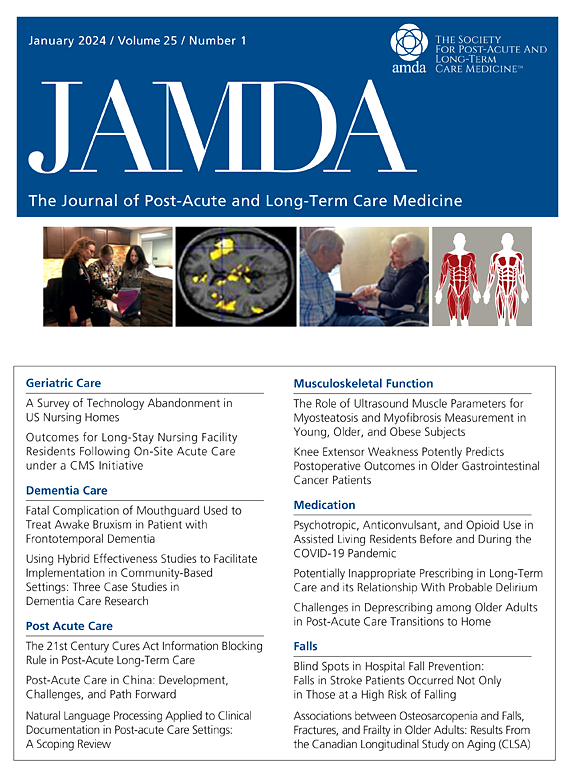Kinematic Insights Into Older Adult Fall-Related Head Impacts: Boundary Conditions and Injury Risk
IF 4.2
2区 医学
Q2 GERIATRICS & GERONTOLOGY
Journal of the American Medical Directors Association
Pub Date : 2025-03-26
DOI:10.1016/j.jamda.2025.105545
引用次数: 0
Abstract
Objectives
To quantify real-world impact conditions of falls, which cause 50% to 90% of older adult traumatic brain injuries, and reconstruct them using dummy headforms to analyze kinematics and injury outcomes.
Design
Mixed-methods: Observational and experimental.
Setting and Participants
An open-access dataset of 118 videos of head impacts at long-term care facilities was used.
Methods
Videos were analyzed to determine head impact occurrence, and for each video with a head impact, fall characteristics were recorded. Perpendicular view fall videos were analyzed using validated model-based image-matching software to track head impact velocities. From the tracked videos, falls were reconstructed with a Hybrid III headform mounted on an inverted pendulum to capture impact kinematics.
Results
Of the 118 fall videos with head impacts, we tracked 29 videos, finding a normal velocity of 1.76 ± 1.02 m/s and a tangential velocity of 1.27 ± 0.95 m/s. Twenty-three of these impacts were reconstructed, producing peak linear acceleration (PLA) 50.2 ± 36.4 g and peak rotational acceleration (PRA) 2.91 ± 2.16 krad/s2. Impacts that occurred against the floor had a 38% higher PLA and a 25% higher PRA compared with wall impacts. Compared with backward and forward falls, lateral falls resulted in 46 and 52 g higher PLA and 3.12 and 4.66 krad/s2 higher PRA, respectively.
Conclusions and Implication
Fall direction and impact surface influenced head impact accelerations, with certain fall configurations, such as lateral falls against tile, posing a greater risk for traumatic brain injuries. These findings provide critical insights into the biomechanics of older adult head impact falls and highlight the need for targeted fall prevention strategies, such as interventions that reduce the occurrence of lateral falls. In addition, this work offers foundational data for designing protective equipment, including headgear and energy-absorbing flooring, optimized for these specific kinematics.
对老年人跌倒引起的头部撞击的运动学洞察:边界条件和受伤风险。
目标:量化真实世界中导致 50%至 90%老年人脑外伤的跌倒撞击条件,并使用假头模重建这些条件:量化现实世界中导致50%至90%老年人脑外伤的跌倒撞击条件,并使用假头型对其进行重建,以分析运动学和损伤结果:设计:混合方法:设计:混合方法:观察法和实验法:方法:对视频进行分析,确定头部撞击的发生率:对视频进行分析以确定头部撞击的发生情况,并记录每段头部撞击视频的跌倒特征。使用经过验证的基于模型的图像匹配软件对垂直视角的跌倒视频进行分析,以跟踪头部撞击速度。根据跟踪到的视频,使用安装在倒立摆上的 Hybrid III 头模对跌倒进行重建,以捕捉撞击运动学:结果:在 118 个有头部撞击的跌倒视频中,我们跟踪了 29 个视频,发现正常速度为 1.76 ± 1.02 m/s,切向速度为 1.27 ± 0.95 m/s。我们对其中 23 个撞击进行了重建,得出的峰值线性加速度 (PLA) 为 50.2 ± 36.4 g,峰值旋转加速度 (PRA) 为 2.91 ± 2.16 krad/s2。与墙壁撞击相比,地面撞击产生的线性加速度峰值高出 38%,旋转加速度峰值高出 25%。与前后跌落相比,横向跌落导致的PLA分别高出46和52 g,PRA分别高出3.12和4.66 krad/s2:坠落方向和撞击面会影响头部撞击加速度,某些坠落结构(如贴着瓷砖的横向坠落)会带来更大的脑外伤风险。这些发现为老年人头部撞击跌倒的生物力学提供了重要的见解,并强调了有针对性的跌倒预防策略的必要性,如减少横向跌倒发生的干预措施。此外,这项研究还为设计防护设备(包括头盔和吸能地板)提供了基础数据,并针对这些特定的运动学原理进行了优化。
本文章由计算机程序翻译,如有差异,请以英文原文为准。
求助全文
约1分钟内获得全文
求助全文
来源期刊
CiteScore
11.10
自引率
6.60%
发文量
472
审稿时长
44 days
期刊介绍:
JAMDA, the official journal of AMDA - The Society for Post-Acute and Long-Term Care Medicine, is a leading peer-reviewed publication that offers practical information and research geared towards healthcare professionals in the post-acute and long-term care fields. It is also a valuable resource for policy-makers, organizational leaders, educators, and advocates.
The journal provides essential information for various healthcare professionals such as medical directors, attending physicians, nurses, consultant pharmacists, geriatric psychiatrists, nurse practitioners, physician assistants, physical and occupational therapists, social workers, and others involved in providing, overseeing, and promoting quality

 求助内容:
求助内容: 应助结果提醒方式:
应助结果提醒方式:


